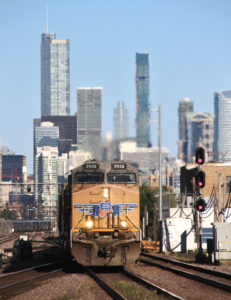
TRAINS: David Lassen
OMAHA, Neb. — Union Pacific’s third-quarter revenue and earnings declined, but cost-cutting and efficiency gains — particularly from running longer trains — helped the railroad produce a new record-low operating ratio.
Operating income fell 9%, to $2 billion, as revenue declined 11%, to $4.9 billion, UP announced on Thursday morning. Earnings per share declined 9%, to $2.01.
UP was able to cut expenses more deeply than revenue declined, resulting in an operating ratio of 58.7%, an 0.8-point improvement over a year ago.
“Our third-quarter results represent another step in our company’s transformation,” CEO Lance Fritz told investors and analysts on the railroad’s earnings call. “We demonstrated our ability to adjust to a sharp rebound in volume, while continuing to provide a safe, efficient, and reliable service product to our customers.”
Volume, affected by the economic impact of the pandemic, fell 4% compared to a year ago but was up 19% compared to the second quarter. Premium volumes, which include intermodal and automotive, grew 5%. Industrial products volume declined 16%, while bulk traffic sank 9%.
Traffic has been trending above last year’s levels since late September and in October is 4% above a year ago, led by an 11% increase in intermodal and automotive volume. The railroad’s bulk business is up 3%, but industrial products lags at a 9% decline.
UP has completed 28 15,000-foot sidings to support the operation of longer trains in both directions, particularly on its single-track routes radiating eastward from El Paso, Texas. Average train length has grown 28%, to 8,984 feet, since UP shifted to an operating plan based on Precision Scheduled Railroading in October 2018.
Chief Operating Officer Jim Vena says average train length could ultimately hit 10,000 feet, while train velocity could improve by another 5% to 10% from current levels.
The railroad saved $79 million by moving tonnage on fewer but longer trains, which was the biggest single driver of productivity savings in the quarter. The train and engine employee count fell 22% compared to a year ago as train starts were reduced and volume declined.
“Our operating model is striking the right balance between service and efficiency,” Vena says.
The railroad’s key operating metrics improved during the quarter, as trains moved faster and cars spent less time in yards. Locomotive and workforce productivity set quarterly records.
But UP’s on-time performance, measured by compliance with trip plans, was mixed. Manifest and automotive carloads met their schedules 72% of the time, a 5-point improvement compared to a year ago. Intermodal trip plan compliance fell 4 points, to 77%, partly due to the surge in volume from the West Coast as retailers looked to restock low inventories.
E-commerce shipments also have risen during the pandemic, a trend Kenny Rocker, UP’s executive vice president of marketing and sales, expects is a fundamental shift in the way people shop.
UP executives said the record rise in intermodal volume — which followed historic declines in the second quarter during the onset of the pandemic — disrupted the entire supply chain, including ports, trucks, dray operators, and rail terminals.
“Everyone was constrained,” Rocker says.
Amid tight West Coast capacity, the railroad imposed increasingly expensive surcharges on infrequent intermodal users to protect customers who use the UP intermodal network year round, Rocker says.
UP also worked with its customers to reduce container dwell at its terminals, as well as to increase use of reservation systems and gate technology.
“As we stand today, real time, we feel really good about where we are. Yes, it was bumpy earlier in the quarter. I think our customers really appreciate how we worked with them up to this point,” Rocker says.
Ongoing intermodal terminal improvements and expansions in Chicago and Houston, where intermodal operations are being consolidated, will help the railroad handle more containers and trailers, officials say.
UP updated its financial outlook for the year. The railroad now expects full year volume to be down 7% and its operating ratio to be below 60%. UP expects to achieve more than $700 million in productivity gains. The company also has resumed share repurchases under its existing share buyback program.









